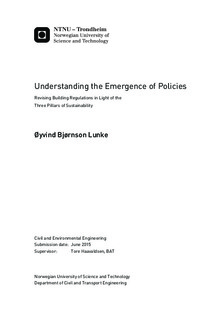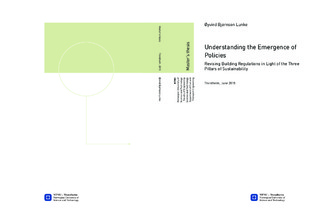| dc.description.abstract | The building regulations for the Norwegian construction industry (TEK10) undergo a major revision in 2015. The regulations have been subject for major critique, both in public media and by building specialists, often because of the increased building cost. Three-pillar sustainability is an explicit criterion for all development in Norway, and the study examines how this is reflected in the making of building policies.
The scope in this study is narrowed, so that the case is limited only to the energy requirements in TEK10. The case study firstly examines to what degree social and economical consequences are taken in consideration when deciding environmental requirements in buildings. Secondly, it looks at the analysis and assessments that lay the basis for the decision of new requirements.
The main research object of this paper is the reports and assessments that form the basis of the formal regulation of construction/housing in Norway. In addition to this documentation study, semi structured, open-ended, in-depth interviews with key actors in the building industry were conducted. An extensive literature review forms the analytic background of the work. The economical and social consequences of new building requirements are significant.
The social and economical consequences are, however, found to be to a smaller degree taken in consideration than the environmental perspective. Higher requirements to energy use in buildings are expected to make houses more expensive, and therefore drive the housing market up.
The interviews show a disagreement with some of the measures central to todays TEK10. The study reveals deficient alternative analysis and impact assessments, and concludes that policies rarely are discussed at a high principle level, and the official reports therefore regard the more practical measures. This might also be the case in other Norwegian policies. | |

